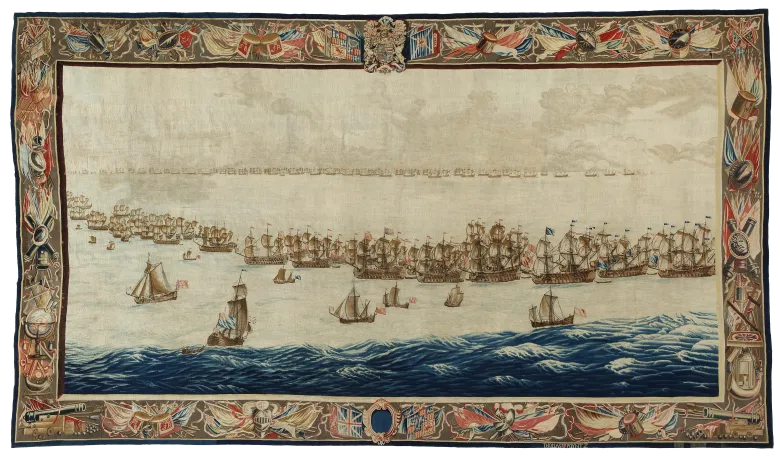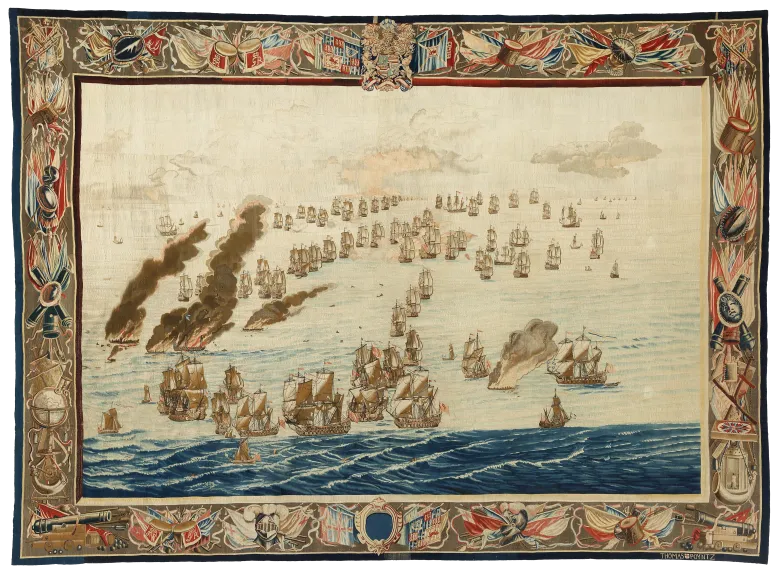The National Maritime Museum in Amsterdam purchased two rare, royally commissioned tapestries designed by Willem van de Velde the Elder (1611-1693) in England.
The tapestries mark the significance of shared Anglo-Dutch heritage. The acquisition is the largest in the history of the museum.
Textile restaurator Lieke Boerstra tells you more on the restauration of the Solebay tapestries designed by Willem van de Velde the Elder.
Willem Van de Velde the Elder
Willem van de Velde the Elder (1611-1693) is widely regarded as one of the most eminent Dutch maritime artists of the seventeenth century. His meticulous and elaborate pen-paintings were very popular in high society and affluent circles all over Europe. Van de Velde and his son Willem, also a celebrated maritime artist, settled in England in the winter of 1672-1673 to work at the royal court on the invitation of King Charles II. There, in addition to various pen-paintings and a few oil paintings, Van de Velde the Elder created the designs for a series of imposing tapestries that were produced at the Mortlake Tapestry Works near London. The tapestries highlight the skill and versatile talent of Van de Velde the Elder. The tapestries are an important addition to the existing collection of sketches, drawings, pen-paintings and paintings of Willem van de Velde the Elder and his son Willem van de Velde the Younger the National Maritime Museum (Het Scheepvaartmuseum).

The Fleets drawn up for Battle, woven after a design by Willem van de Velde the Elder, 5,87 x 3,30 metres, woven after 1685.
Battle of Solebay
The tapestries depict two scenes from the battle that took place off the east coast of England, near Solebay in Suffolk, on 7 June 1672. The naval engagement between the Dutch and joint English-French fleet was the opening battle of the Third Anglo-Dutch War (1672-1674). The Dutch fleet of over a 100 warships and 20,000 crew members was commanded by Lieutenant Admiral Michiel Adriaensz de Ruyter. On the day of the battle Van de Velde the Elder was present and, as an embedded war correspondent, captured the unfolding events at sea in several sketches onboard a Dutch sailing boat. He later made more elaborate drawings of the battle in the comfort of his own studio. Although the outcome of the naval battle remained undecided, it was celebrated as a victory on both sides.

The Burning of the Royal James (Later in the Day), woven after a design by Willem van de Velde the Elder, 4,57 x 3,30 metres, woven after 1685.
Royal commission
After he settled in Greenwich, Van de Velde the Elder adapted his original drawings for the design of the series of tapestries as part of two royal commissions, first by King Charles II in ca. 1672 and in 1685 for a second series at the request of King James II. These tapestries were woven by Thomas Poyntz at the Mortlake Tapestry Works near London. The largest tapestry, measuring an impressive 6 by 3.3 metres in size, depicts the formation of the fleets preceding the battle. The second tapestry of 4.5 by 3.3 metres depicts a successful Dutch fireship attack on the Earl of Sandwich’s imposing English flagship Royal James.
Unique craftsmanship
The magnificent tapestries are a superb complement to the drawings, pen paintings and oils by Willem van de Velde the Elder and his son Willem van de Velde the Younger in the National Maritime Museum collection and the National Collection. As well as demonstrating the expertise, versatility, talent and ambition of Willem van de Velde the Elder, they also testify to the extent of the royal patronage the Van de Veldes enjoyed at the English court. Here they received major commissions from both King Charles II and his brother and successor James II, who were both keenly interested in the Royal Navy. The tapestries were woven by Thomas Poyntz at the Mortlake factory near London, forming a unique example of contemporary craftsmanship. While twelve tapestries were made in all, these two works are rare: they are the only examples on display outside the United Kingdom. The textiles have recently undergone a thorough restoration and study.
The tapestries are shown here for the first time in the Willem van de Velde & Son exhibition. Now they are on show in the East gallery of the museum.
The Solebay tapestries were acquired with support from Vereniging Rembrandt (and subsidiary Rembrandt UK Circle Fund) and Mondrian Fund, together with the Ministry of ECS Nationaal Aankoopfonds, Vereeniging Nederlandsch Historisch Scheepvaart Museum, VriendenLoterij, Samenwerkende Maritieme Fondsen and Het Compagnie Fonds.